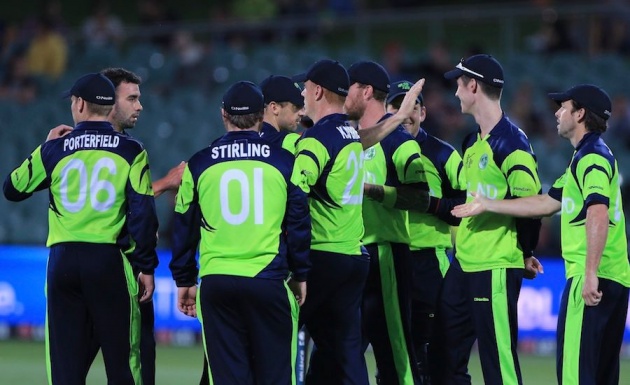March 16, 2015
How to make a ten-team World Cup work
The World Cup has strolled in leisurely fashion through what had been billed as the round of dull predictability. But it can be said upon reflection, and with a degree of gratefulness, that neither have the last four weeks been dull nor have they been predictable. In the end, seven of the eight teams fancied to feature in the quarters have made it - some just about. Three matches in the first round were virtual knockouts, and it took until the last day of the first round for the last two teams to get on board.

Once again, it is to Ireland that the World Cup owes a big thank you. And to England - if you want to be cruel. By causing one major upset in three successive World Cups - against Pakistan in 2007, England in 2011, and West Indies in 2015 - Ireland have kept the first part of the tournament bubbling. England kept it alive and open with ineptitude. In 2011, they managed to sneak through despite losing to Ireland and Bangladesh, but this time Bangladesh took their place in the last eight by rights. They might have had a slice of fortune by way of the washout that allowed them to split points with Australia, but the way the group stage ended, it wouldn't have mattered: over the five weeks, Bangladesh were better than England.
Further, the first round remained enjoyable till the end, for the subplots it provided. New Zealand set the tone by unleashing a breathtakingly aggressive brand of cricket. With the bat it has been done before, but Brendon McCullum went for broke with the ball too, bowling out both England and Australia by using up his wicket-taking bowlers in the first 30 overs.
India surprised the world by rousing themselves from a slumber and topping their group in a manner that left even their most ardent fans nonplussed. A group of bowlers who hadn't managed to bowl out a side all summer, captured 60 wickets in six matches, the only team to do so this World Cup. It is a first in India's ODI history. Even after it had become clear they couldn't be dislodged from pole position, whether they would be able to bowl out their opponents remained a matter of interest - as it did with New Zealand, who were denied by Bangladesh.
Afghanistan managed to win a World Cup match in their first tournament, denying Scotland their own first in a thrilling one-wicket win achieved with a last over-boundary. Such was the depth of England's misery that even their otherwise meaningless final match, against Afghanistan, carried significance: it was a match they couldn't afford to lose.
There was the running thread between India and Pakistan; Pakistan's own story of finding a stirring bowling performance when they appeared to be sinking; the trans-Tasman bowl-out; Ireland beating Zimbabwe with a catch on the rope to stay alive; and South Africa raising mountains while batting first but stumbling in chases.
The pull of sport lies not merely in the pleasures and pains of triumphs and defeats but also in the textures and the layers of the stories that have come along the way. The next 12 days will define this World Cup, but the last four weeks have given us more than the mere routine of setting up the inevitable.
That inevitable, of course, was that the Associates would go home, leaving the top eight to begin the real business of winning the World Cup. Bangladesh's presence is a welcome change to the plot, but it doesn't largely alter the reality that a team can be more or less abysmal for a month and still end up in the final on the back of two good days.
The problem with the World Cup has never been the presence of the Associates, but the format, which has been designed to keep the "revenue- earning" teams in the tournament for as long as possible. In principle, 2007 had a better format - 16 teams, four groups, with eight qualifying to the second round - but the unanticipated departures of India and Pakistan wrought commercial calamity.
There is an argument that the current format could be made far more competitive and meaningful simply by taking away the quarter-finals. Putting that into practice here, it would have left New Zealand, India, Australia and South Africa fighting it out for the trophy, and there would be no argument against the merits of those four teams. But of course, it would meant four fewer marquee games on television, and who could have guaranteed at the start of the tournament that India, on whom rides the financial viability of the tournament, would end in the top four?

And so to the idea of a ten-team World Cup: more matches between relatively evenly matched teams, more meaning, tighter contests, and of course a far more lucrative tournament. Despite the feel-good factor the presence of minor nations brought, it is true that as the tournament wore on, the gaps between the weaker and stronger teams widened. A case was made for close contests featuring the Associates, but invariably those happened between two weak teams.
Barring Ireland, no other Associate managed to put in a contest. Afghanistan had Sri Lanka in a bother for a while, but once Mahela Jayawerdene took charge, the outcome became a formality. And even Ireland, once that win against the underperforming West Indies was out of the way, never looked capable of challenging a top nation.
A parallel is often drawn with the football World Cup, but it ignores football's much wider base and the fact that an uncompetitive game there lasts only 90 minutes, against one-day cricket's eight-odd hours.
However, it is easy to see why cricket fans love the idea of Associates in the World Cup. Who with their heart in the right place doesn't love a good romance? The Associates bring freshness, the joy of the unexpected, an amateur spirit, and they give cricket fans a worthy and ennobling pleasure: being able to root for the underdog, and occasionally, the reward of a thrilling upset.
Between commercial pragmatism and romance, cricket must find common ground. Sachin Tendulkar has spoken of a 25-team tournament and Martin Crowe has put forward the idea of an 18-team World Cup lasting ten weeks. In the spirit of the moment, here's one more idea.
The ten-team World Cup can stay, but why not simply add a qualifying leg to the main tournament? The idea put forward by Wally Edwards, the Cricket Australia chairman, to rebrand ODIs as World Cup cricket is worthy of serious consideration. It is, of course, impossible to regulate the number of ODIs each country wants to play, but let there be a minimum number of matches each team must play. The top six teams can then qualify directly for the World Cup, and the bottom eight can play in the first round of the World Cup, with the top four from there joining the second round. It will then feel like one long, seamless tournament but with every match invested with significance, and the matches in the first round will be between more evenly matched teams. And most of all, they will take place on a stage that the minor nations crave and deserve.
It is simplistic, and somewhat misinformed, to demonise the ICC for its treatment of the Associates. The fact is that there have been many in the organisation who have championed and worked tirelessly for the cause for years. The Afghanistan story, among the most uplifting in sport, wouldn't have been possible without these efforts. But that spirit often finds itself at odds with the immediate commercial interests of the ICC board, which is ruled by a smaller group.
Still, a middle ground can be found. The world doesn't have to thrown out of the World Cup to make it a tournament. With vision, will and some flexibility, it can be an exclusive competition while staying inclusive.
Sambit Bal is editor-in-chief of ESPNcricinfo. @sambitbal



